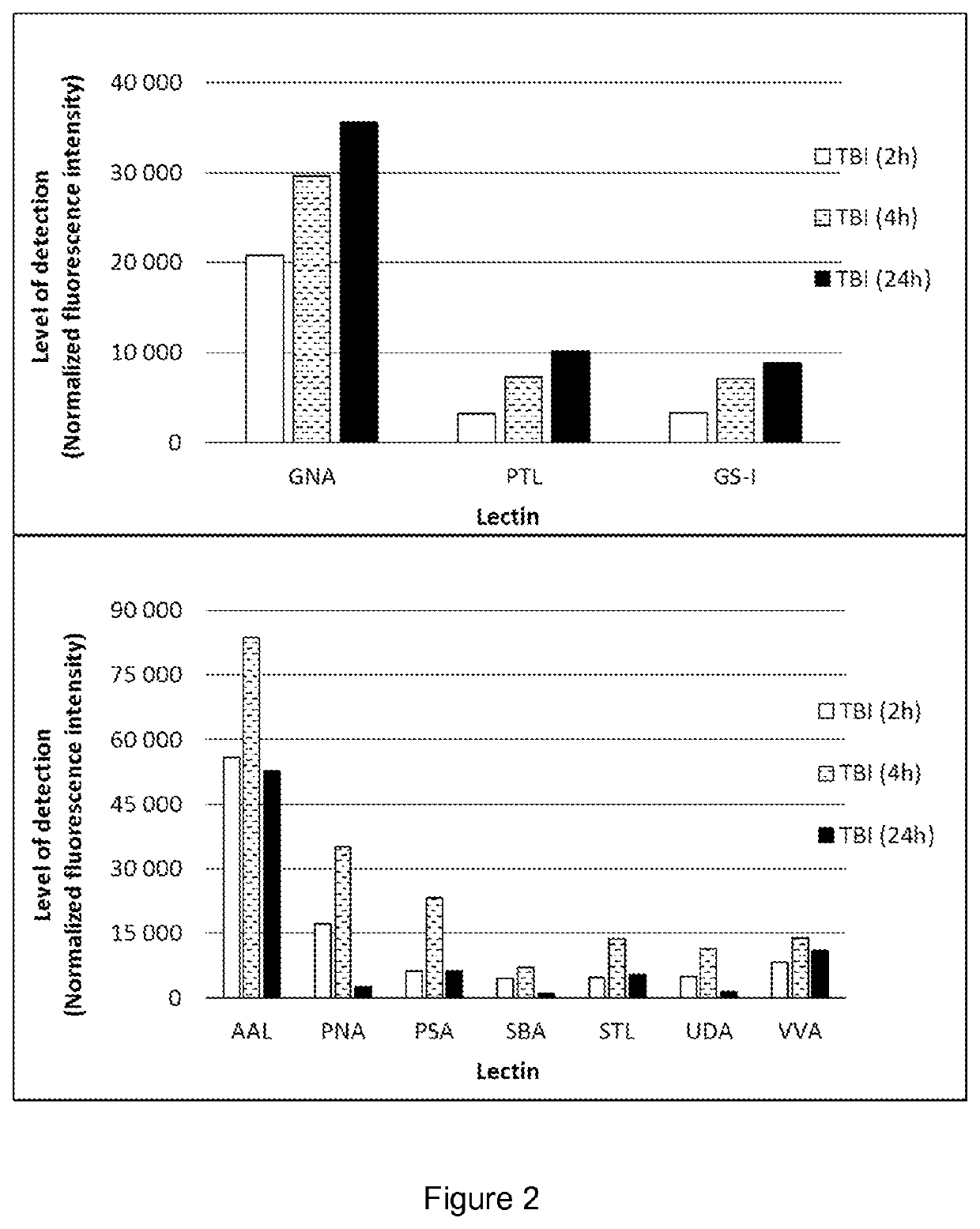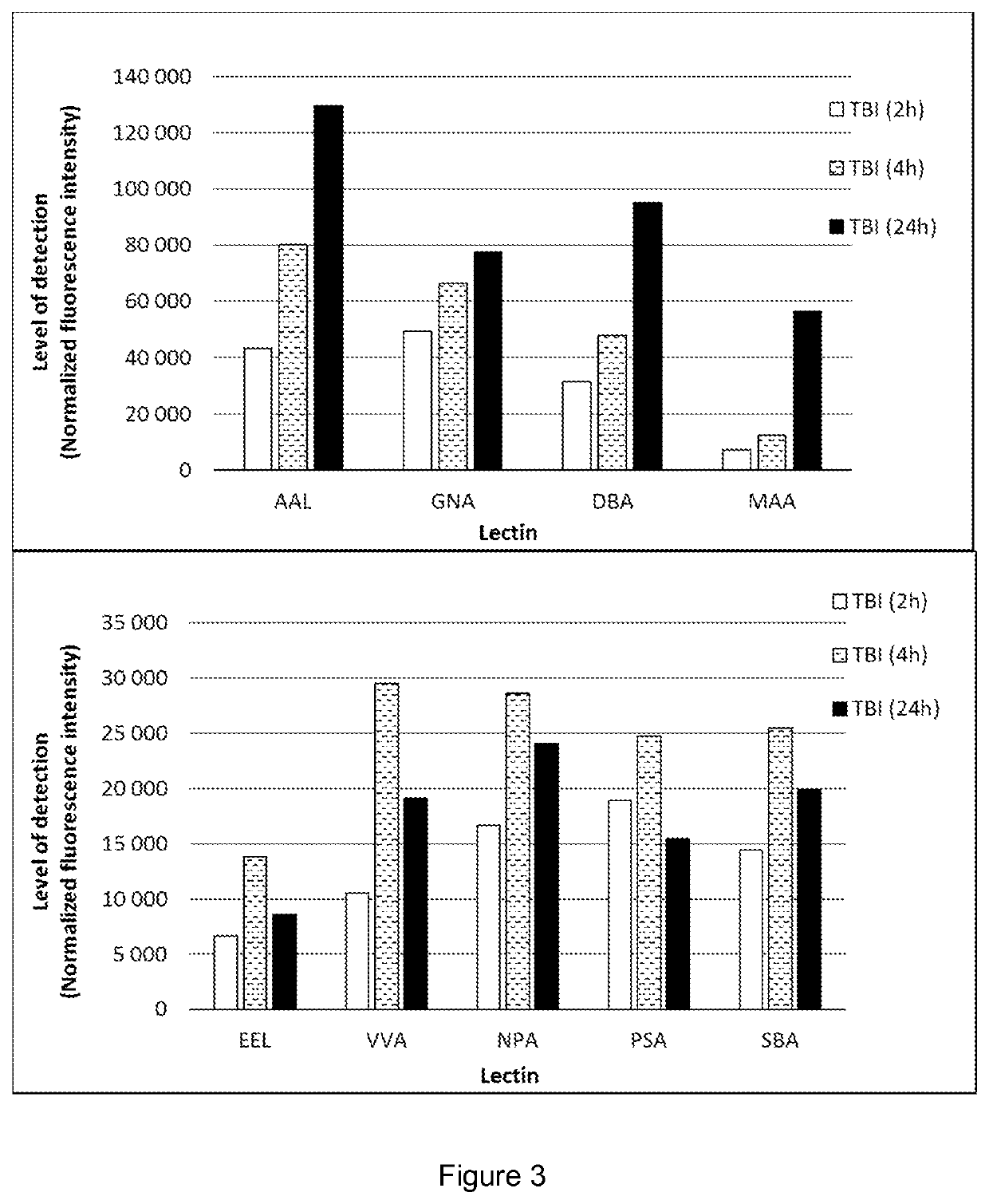Prognostic and diagnostic glycan-based biomarkers of brain damage
a biomarker and brain damage technology, applied in the direction of peptide/protein ingredients, peptide sources, instruments, etc., can solve the problems of complex brain injury, unexplored pathological condition, and inability to diagnose brain damage, so as to achieve the effect of diagnosing, monitoring or prognosing a brain injury
- Summary
- Abstract
- Description
- Claims
- Application Information
AI Technical Summary
Benefits of technology
Problems solved by technology
Method used
Image
Examples
example 1
[0074]A mouse model of experimental closed head injury disclosed by Yatsiv et al. in FASEB J. 2005, 19:1701-1703 is employed for identifying changes, increase or decrease, in the level of glycan-based biomarkers after a head trauma caused by a weight-drop onto an exposed skull.
[0075]Severity of the injury is assessed according to the Neurological Severity Score disclosed by Beni-Adani et al. (J. Pharmacol. Exp. Ther. 2001, 296:57-63) on the basis of ten individual tasks reflecting motor function, alertness, and behaviour. Severity assessment is carried out 1 hour and 7 days after the trauma in order to allocate the mice into comparable study groups in order to find a correlation between the severity of damage and level of detected biomarker.
[0076]After euthanization, body fluids (including urine, blood plasma or serum, and CSF) from normal and brain injured animals are collected and analysed for glycan-based biomarkers using a lectin assay, and the brains are evaluated histologicall...
example 2
[0077]A rat model of experimental closed head injury disclosed by Bilgen et al. (Neurorehabil. Neural Repair, 2005, 19:219-226) with some modifications is employed for identifying changes, increase or decrease, in the level of glycan-based biomarkers after a head trauma.
[0078]In vivo T2 weighted magnetic resonance imaging (MRI) is performed on the animals to depict the pathologies, including lesion size, tissue viability, and brain oedema, of the resulting injuries in the corresponding neuronal tissues at 24 h and day 3.
[0079]After euthanization, histological evaluation of the injury in the cortex and hippocampus is performed. Additionally, body fluids (including urine, blood plasma or serum, and CSF) from normal and brain injured animals are collected and analysed for glycan-based biomarkers using a lectin assay.
example 3
[0080]A controlled cortical impact was carried out to exposed dura of anesthetized rats according to Bilgen et al. (Neurorehabil. Neural Repair, 2005, 19:219-226) with modifications. The animals were terminated at various times elapsed after the operation. Samples of urine, blood plasma, saliva and cerebrospinal fluid (CSF) were collected and processed using regular methods well known to professionals skilled in the art.
[0081]The samples were incubated on a lectin array, and after washing, a fluorescent conjugate was allowed to bind to the captured glycans or glycan-containing complexes. The spots were visualized and the fluorescence intensities were recorded with a laser scanner.
[0082]The results summarized in FIGS. 1 to 3 prove that the body fluids of TBI animals contain glycans or glycan-containing complexes showing significantly elevated binding to particular lectins, compared with the fluids of the sham animals. By selecting appropriate lectins, the TBI detection kit can be adj...
PUM
| Property | Measurement | Unit |
|---|---|---|
| CT | aaaaa | aaaaa |
| magnetic resonance imaging | aaaaa | aaaaa |
| MRI | aaaaa | aaaaa |
Abstract
Description
Claims
Application Information
 Login to View More
Login to View More - R&D
- Intellectual Property
- Life Sciences
- Materials
- Tech Scout
- Unparalleled Data Quality
- Higher Quality Content
- 60% Fewer Hallucinations
Browse by: Latest US Patents, China's latest patents, Technical Efficacy Thesaurus, Application Domain, Technology Topic, Popular Technical Reports.
© 2025 PatSnap. All rights reserved.Legal|Privacy policy|Modern Slavery Act Transparency Statement|Sitemap|About US| Contact US: help@patsnap.com



